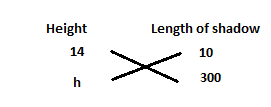11th Grade > Statistics
PRESENTATION OF DATA MCQs
Total Questions : 30
| Page 2 of 3 pages
Answer: Option A. ->
Footnote
:
A
Footnotes are not mandatory and are mostly used to simply explain a feature of the table that is neither self explanatory nor one that’s been explained before.
:
A
Footnotes are not mandatory and are mostly used to simply explain a feature of the table that is neither self explanatory nor one that’s been explained before.
Answer: Option A. ->
True
:
A
Area of the rectangle represents the frequency of the class interval considered.
:
A
Area of the rectangle represents the frequency of the class interval considered.
Answer: Option A. ->
Multiple Bar Diagram
:
A
Since the data to be presented has 2 bars of the same category(the most poor and the least poor) and it is required to show the trends of these in the last 5 years, multiple bar diagram is the best suited for a graph.
:
A
Since the data to be presented has 2 bars of the same category(the most poor and the least poor) and it is required to show the trends of these in the last 5 years, multiple bar diagram is the best suited for a graph.
Answer: Option C. ->
Component bar diagram
:
C
Since the total sales and the breakdown of sales by models are required to be presented for each manufacturer, we can make use of component bar diagrams for this purpose. If only the total sales were required, a simple bar diagram would have sufficed.
:
C
Since the total sales and the breakdown of sales by models are required to be presented for each manufacturer, we can make use of component bar diagrams for this purpose. If only the total sales were required, a simple bar diagram would have sufficed.
Answer: Option A. ->
Non-increasing graph
:
A
For more than ogive, more than cumulative frequencies are plotted against the lower class boundaries of that class. Here, frequencies are subtracted from the total, starting from the lower limit of the 1st class interval of the frequency distribution. The cumulative total tends to decrease or remain the same. Hence it is a non-increasing graph.
:
A
For more than ogive, more than cumulative frequencies are plotted against the lower class boundaries of that class. Here, frequencies are subtracted from the total, starting from the lower limit of the 1st class interval of the frequency distribution. The cumulative total tends to decrease or remain the same. Hence it is a non-increasing graph.
Answer: Option B. ->
False
:
B
In all circumstances, organisation of data precedes presentation of data. Only when the data are organised, it can be understood and be presented in the right way.
:
B
In all circumstances, organisation of data precedes presentation of data. Only when the data are organised, it can be understood and be presented in the right way.
Answer: Option C. ->
42% - Company A
46% - Company B
:
C
For company A ,
% of profits earned in 2015 - 16
=250600×100
= 42%
For company B,
% of profits earned in 2015 - 16
=300650×100
= 46%.
46% - Company B
:
C
For company A ,
% of profits earned in 2015 - 16
=250600×100
= 42%
For company B,
% of profits earned in 2015 - 16
=300650×100
= 46%.
Answer: Option A. ->
Discrete data
:
A
Bar diagram comprises a group of equi-spaced and equi-width rectangular bars for each class or category of data. It is plotted only for discrete data.
:
A
Bar diagram comprises a group of equi-spaced and equi-width rectangular bars for each class or category of data. It is plotted only for discrete data.
Answer: Option A. ->
True
:
A
All less than ogives are non-decreasing graphs. As you go down the class interval, cumulative frequencies can only increase or stay the same.
:
A
All less than ogives are non-decreasing graphs. As you go down the class interval, cumulative frequencies can only increase or stay the same.
Answer: Option A. ->
Unit of measurement
:
A, B, and D
Without the unit of measurement, it is not understood if income is given in 1000's of Rupees, or Rupees. Indexing or adding table number helps in identification and understanding of the given information. Lastly, there is no title to these tables. Hence nothing can be inferred from the given data.
:
A, B, and D
Without the unit of measurement, it is not understood if income is given in 1000's of Rupees, or Rupees. Indexing or adding table number helps in identification and understanding of the given information. Lastly, there is no title to these tables. Hence nothing can be inferred from the given data.

















